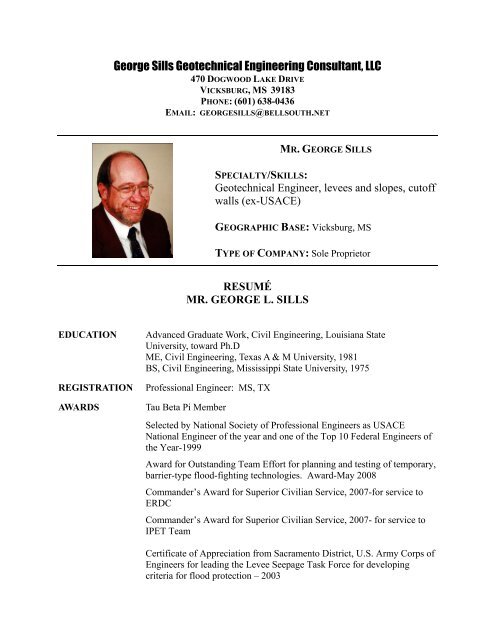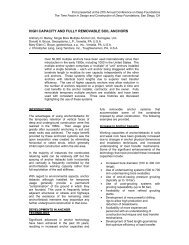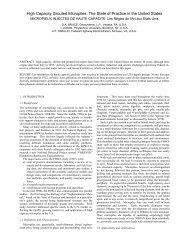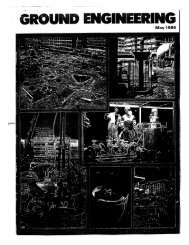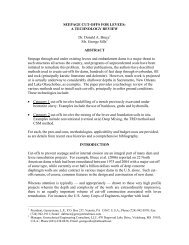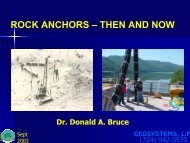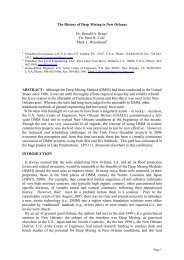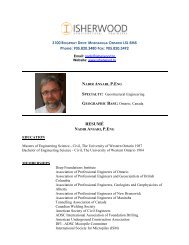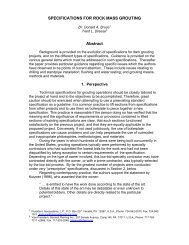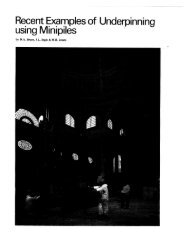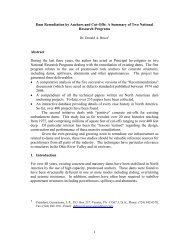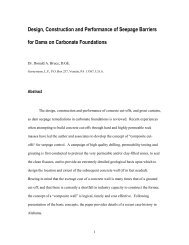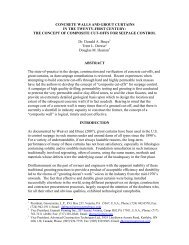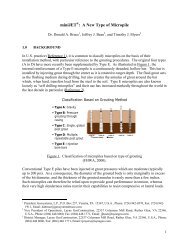George Sills Geotechnical Engineering Consultant, LLC
George Sills Geotechnical Engineering Consultant, LLC
George Sills Geotechnical Engineering Consultant, LLC
Create successful ePaper yourself
Turn your PDF publications into a flip-book with our unique Google optimized e-Paper software.
<strong>George</strong> <strong>Sills</strong> <strong>Geotechnical</strong> <strong>Engineering</strong> <strong>Consultant</strong>, <strong>LLC</strong><br />
470 DOGWOOD LAKE DRIVE<br />
VICKSBURG, MS 39183<br />
PHONE: (601) 638-0436<br />
EMAIL: GEORGESILLS@BELLSOUTH.NET<br />
MR. GEORGE SILLS<br />
SPECIALTY/SKILLS:<br />
<strong>Geotechnical</strong> Engineer, levees and slopes, cutoff<br />
walls (ex-USACE)<br />
GEOGRAPHIC BASE: Vicksburg, MS<br />
TYPE OF COMPANY: Sole Proprietor<br />
RESUMÉ<br />
MR. GEORGE L. SILLS<br />
EDUCATION<br />
REGISTRATION<br />
AWARDS<br />
Advanced Graduate Work, Civil <strong>Engineering</strong>, Louisiana State<br />
University, toward Ph.D<br />
ME, Civil <strong>Engineering</strong>, Texas A & M University, 1981<br />
BS, Civil <strong>Engineering</strong>, Mississippi State University, 1975<br />
Professional Engineer: MS, TX<br />
Tau Beta Pi Member<br />
Selected by National Society of Professional Engineers as USACE<br />
National Engineer of the year and one of the Top 10 Federal Engineers of<br />
the Year-1999<br />
Award for Outstanding Team Effort for planning and testing of temporary,<br />
barrier-type flood-fighting technologies. Award-May 2008<br />
Commander’s Award for Superior Civilian Service, 2007-for service to<br />
ERDC<br />
Commander’s Award for Superior Civilian Service, 2007- for service to<br />
IPET Team<br />
Certificate of Appreciation from Sacramento District, U.S. Army Corps of<br />
Engineers for leading the Levee Seepage Task Force for developing<br />
criteria for flood protection – 2003
Commander’s Award for Civilian Service-1995, 1999<br />
Commander’s Award for Community Service-1994, 1999<br />
Appointed to MS State University National Board of Directors and<br />
recipient of the Distinguished Service Award-1994<br />
Commander’s Award for Civilian Service-1994. During the 1993 Midwest<br />
flood, <strong>George</strong> served as technical advisor for the USACE St. Louis<br />
District to answer seepage related questions in the field during the flood<br />
event.<br />
PROFESSIONAL<br />
SUMMARY<br />
<strong>George</strong> currently serves as manager of his private consultant company,<br />
<strong>George</strong> <strong>Sills</strong> <strong>Geotechnical</strong> <strong>Engineering</strong> <strong>Consultant</strong>, <strong>LLC</strong>, which he opened<br />
in 2008. <strong>George</strong> is retired from the U.S. Army Corps of Engineers<br />
(Corps) where he worked for over 36 years. He was employed by the<br />
Vicksburg District for 32 of those years and the Engineer Research &<br />
Development Center (ERDC) for 4 years. He has extensive experience in<br />
the evaluation, design, and construction of dams, levees, pumping plants,<br />
and flood fighting. <strong>George</strong> has lead several investigations into the causes<br />
and mechanisms of seepage distress along levees and has helped the Corps<br />
develop a comprehensive understanding of these issues. He has lectured<br />
and published numerous technical papers on levee seepage distress and<br />
levee design.<br />
While at ERDC, <strong>George</strong> led the joint Corps and Bureau of Reclamation<br />
(Reclamation) team that developed a toolbox for use in performing<br />
Probabilistic Risk Assessments (PRAs) on Corps and Reclamation dams<br />
with regard to seepage and piping distress. Much of this effort involved<br />
leading a diverse group to resolve complex and conflicting guidance<br />
criteria to create useable tools for practitioners from different agencies.<br />
<strong>George</strong> also served on the Corps’ National Levee Safety Program to help<br />
set policy/methodology for Corps levee assessments in the future. <strong>George</strong><br />
also led the team assigned to rewrite the Corps Levee Design <strong>Engineering</strong><br />
Manual, which instructs engineers in proper design procedures for levee<br />
underseepage. This document is currently in draft form and undergoing<br />
review.<br />
<strong>George</strong> served on a team from 2006 through 2007 to provide Independent<br />
Technical Review of the design for repairs to the Herbert Hoover Dike in<br />
Florida. This 145-mile-long dam/dike was constructed over peat and<br />
limestone which created seepage problems. Currently, <strong>George</strong> is a<br />
member of the Independent Consulting Board reviewing the ongoing<br />
design work for urban and non-urban levees in the Central Valley of<br />
California. He also serves on the Senior Board of <strong>Consultant</strong>s for the<br />
review of levee designs for the Natomas Levee Improvement Program for<br />
the Sacramento Area Flood Control Agency. He also serves on a similar<br />
Board of Senior <strong>Consultant</strong>s for the Cities of West Sacramento, CA,
Sutter-Butte, CA, and Dallas, TX. During 2008, <strong>George</strong> was selected and<br />
served as a member of the National Levee Safety Committee Review<br />
Team which reviewed the new levee proposals made to Congress.<br />
In 2005, <strong>George</strong> was selected to serve on the Corps’ Interagency<br />
Performance Evaluation Task Force (IPET) following Hurricane Katrina<br />
as a member of the Perishable Data Team and also as a member of the<br />
Performance Analysis Team. He made major contributions to these efforts<br />
and to the IPET document that summarized the team’s findings. He has<br />
also testified in court about their efforts on this study.<br />
During 2003, <strong>George</strong> was selected to lead the Sacramento District (SPK)<br />
Levee Seepage Task Force. The Task Force consisted of six levee experts:<br />
two from the federal government, one from the State of California, one<br />
private consultant, and two consultants from universities. <strong>George</strong> led this<br />
diverse team to accomplish their mission within budget and within<br />
schedule. <strong>George</strong> later took the information from this study and wrote an<br />
<strong>Engineering</strong> Technical Letter to change procedures currently used by<br />
USACE for their nationwide approach to seepage design.<br />
While at the Vicksburg District, Mr. <strong>Sills</strong> led a study to determine the<br />
effects on area groundwater along the Red River which might occur from<br />
impounding the pools for navigation on the Red River.<br />
RELEVANT<br />
EXPERIENCE<br />
1994-2003<br />
• While working at the Vicksburg District <strong>George</strong> performed the<br />
following as a <strong>Geotechnical</strong> Coordinating Specialist: <strong>George</strong> assisted<br />
the Branch Chief with the overall management, direction, control,<br />
administration, planning, and review of the engineers and design<br />
functions of the <strong>Geotechnical</strong> Branch of the Vicksburg District<br />
(MVK). He evaluated technical staffing and performance and made<br />
recommendations on the most economical, efficient, and feasible<br />
methods and/or manner to accomplish work. He also established<br />
schedules and priorities. He served as Technical Expert and <strong>Consultant</strong><br />
for guidance and recommendations to MVK, other Corps Districts, A-<br />
E firms, and higher Corps echelons. During this period, <strong>George</strong> led<br />
the design effort for the soil nailing of the Natchez Bluffs.<br />
July 1994-December 1994<br />
• Served as a Project Engineer in the Programs and Project Management<br />
Division, managing the $1.8 billion Red River Basin Project. Daily, he<br />
coordinated all District functions concerning District policies and<br />
procedures. He served as major liaison between the project sponsor<br />
and Corps. He also worked closely with Congressional staff in order<br />
to meet project milestones. He used innovative problem solving<br />
techniques to enable the District to begin pool impoundments as<br />
scheduled.
December 1994-December 1995<br />
• Supervisory Civil Engineer, GS-0810-13, Acting Chief of the<br />
Analytical Section with the responsibility of supervising twelve<br />
engineers and professionals. This responsibility included personnel<br />
and administrative matters as well as scheduling and programming<br />
funds. During this period, the Section met or exceeded all schedule<br />
requirements and operated within budget requirements.<br />
December 1989-July 1994<br />
• <strong>Geotechnical</strong> Specialist responsible for the designs and reviews of all<br />
geotechnical work associated with the Red River Project. This work<br />
included designing the foundations for the locks and dams, dewatering<br />
requirements, and all other <strong>Geotechnical</strong> requirements. During this<br />
project, <strong>George</strong> invented a method of slide repair reported in ASCE<br />
and currently used by private and government sectors.<br />
January 1991-November 1991<br />
• Served as a professional specialist in Project Management, CEMVD<br />
General Management Branch. Responsibilities included executing the<br />
project management function for <strong>Engineering</strong> Division by furnishing<br />
staff assistance and managerial and technical advice to Districts and<br />
MVD staff. He also coordinated the review of reports and studies,<br />
monitored District schedules, identified potential slippages, and took<br />
corrective action when necessary.<br />
January 1981-December 1989<br />
• Served as Project Engineer in the Analytical Section where <strong>George</strong><br />
was responsible for geotechnical design of complex multimillion<br />
dollar projects, as well as supervision of as many as 20 engineers and<br />
professionals in the execution of field testing operations. These field<br />
tests included the pile load test at John H. Overton Lock and Dam for<br />
a period of 8 months, as well as field pumping tests at Locks and<br />
Dams No. 4 and 5 on the Red River. He was also responsible for<br />
programming funds for the entire Red River in CEMVK-ED-G.<br />
<strong>George</strong> was the primary point of contact for design and/or construction<br />
problems for Locks and Dams No. 2, 3, 4, and 5 on the Red River.<br />
Concrete Locks and Dams<br />
• Served as <strong>Geotechnical</strong> Project Engineer for the Red River Waterway<br />
Project and was responsible for designing and reviewing all<br />
<strong>Geotechnical</strong> designs of this $1.8 billion dollar project. This design<br />
work included the foundations for the locks and dams, dewatering<br />
requirements, and all other <strong>Geotechnical</strong> requirements.<br />
• <strong>Geotechnical</strong> Project Engineer for the Joe D. Waggoner, Jr. L&D<br />
(Lock & Dam No. 5) on the J. Bennett Johnston Waterway Project<br />
(Red River Waterway). His design and construction experience on<br />
this project included a slurry trench design and dewatering wells to<br />
unwater the excavation. He also led a field pumping test at this site.<br />
• <strong>Geotechnical</strong> Project Engineer for the design and construction of the<br />
Russell B. Long L&D (Lock & Dam No. 4) on the Red River
Waterway, this design included a slurry trench, dewatering wells, and<br />
excavation through a rock formation. He also led a field pumping test<br />
at this site.<br />
• <strong>Geotechnical</strong> Project Manager for Lock & Dam No. 3 for the design<br />
and construction which also included a field pump test.<br />
• <strong>Geotechnical</strong> Project Manager for John H. Overton L&D (Lock &<br />
Dam No. 2) for the construction phase which included the redesign of<br />
the field pile load test program. The pile test program was modified<br />
using a method never tried before. Because of these changes, the<br />
modified program was able to collect more useable data while saving<br />
the Government a sum of $450,000.<br />
• <strong>Geotechnical</strong> Project Manager for the construction of Lindy C. Boggs<br />
L&D (Lock & Dam No. 1) where he answered all geotechnical related<br />
questions during construction.<br />
• <strong>Geotechnical</strong> Engineer performing all phases of geotechnical design<br />
for the foundation of Felsenthal L&D and T.K. Thatcher L&D (Calion<br />
L&D) on the Ouachita-Black Navigation Project.<br />
Dams and Levees<br />
• Served on a group to provide Independent Technical Review for the<br />
Herbert Hoover Dike in Florida. This 145 mile long dam/dike was<br />
constructed over peat and limestone which has created seepage<br />
problems. This review team was responsible for assuring the safety of<br />
the design repair.<br />
• He led a diverse team of Corps, State of California personnel, and<br />
leading academic experts to review the Sacramento Districts practices<br />
of levee construction. Results from this study have led to major<br />
changes in the procedures the Corps used nationwide in levee design.<br />
• <strong>Geotechnical</strong> Engineer managing the geotechnical designs of the<br />
Sicily Island Levee system. This project included numerous drainage<br />
structures, several large pumping plants, and approximately 70 miles<br />
of levees.<br />
• <strong>Geotechnical</strong> Engineer designing numerous miles of mainline<br />
Mississippi River Levee enlargements that included stability berms,<br />
seepage berms, and relief well designs.<br />
• <strong>Geotechnical</strong> Engineer designing and providing construction design<br />
support for the Swan Lake levee project. This project was constructed<br />
over very soft soils with shear strengths less than 100 psf.<br />
• <strong>Geotechnical</strong> Project Manager for the geotechnical design for the<br />
earthen closures at Locks & Dams 2, 3, 4, and 5 on the Red River. All<br />
these closures were constructed in the wet.<br />
Other Experience<br />
• <strong>George</strong> has worked on numerous deep slurry trenches and has been<br />
heavily involved both in design and in the oversight of construction.<br />
He is widely known as an expert in several fields of <strong>Geotechnical</strong><br />
<strong>Engineering</strong>.<br />
• Publication and expertise in long-term behavior of soils and slope
PUBLICATIONS Approximately 50.<br />
stability, pile design and driving.<br />
• Experience in dewatering, slope stability, slurry trench design and<br />
construction, ground water movements, seepage, and foundation<br />
design.<br />
• Ameristar Casino (Vicksburg) – review of cofferdam cell keyed into<br />
limestone that was sliding – including the development of<br />
recommendations to stabilize (for Sverdrup).<br />
• Served as lead geotechnical designer for the $1.8 billion Red River<br />
Waterway project that included five locks and dams. Work included<br />
pile design, cofferdam cells, dewatering, slope stability, etc.<br />
• Invented a method of slide repair using stone filled trenches that was<br />
later published by the American Society of Civil Engineers.<br />
• Responsible geotechnical engineer for the Natchez Bluff Stabilization<br />
Project which used “soil nailing”.<br />
Expert Witness for Litigation<br />
• 2006 testified on IPET forensic work for New Orleans in: Colleen<br />
Berthelot, et al., v. BOH Brothers Construction Co., <strong>LLC</strong>, et al., Civil<br />
Action No. 05-4182, May 4, 2006, United States District Court, E.D.<br />
Louisiana.<br />
• Calion Lock and Dam - dewatering and differing site condition<br />
construction claim - a second claim for rock in the outlet channel.<br />
• Felsenthal Lock and Dam - dewatering construction claim<br />
• John H. Overton Lock and Dam - access road construction claim<br />
differing site conditions<br />
• Lock and Dam No. 3 - access road claim - differing site conditions<br />
construction claim<br />
• Lock and Dam No. 4 - differing site conditions construction claim -<br />
rock in the inlet channel evaluation of difficult driving of sheep pile in<br />
rock<br />
• Provided technical assistance to EPA in trial conducted in Texas<br />
(1995).<br />
• Provided testimony and assistance concerning “sudden drawdown<br />
failures” in lawsuit defended by the Red River Waterway Commission<br />
• Provided numerous depositions in the above listed cases and disputes.


